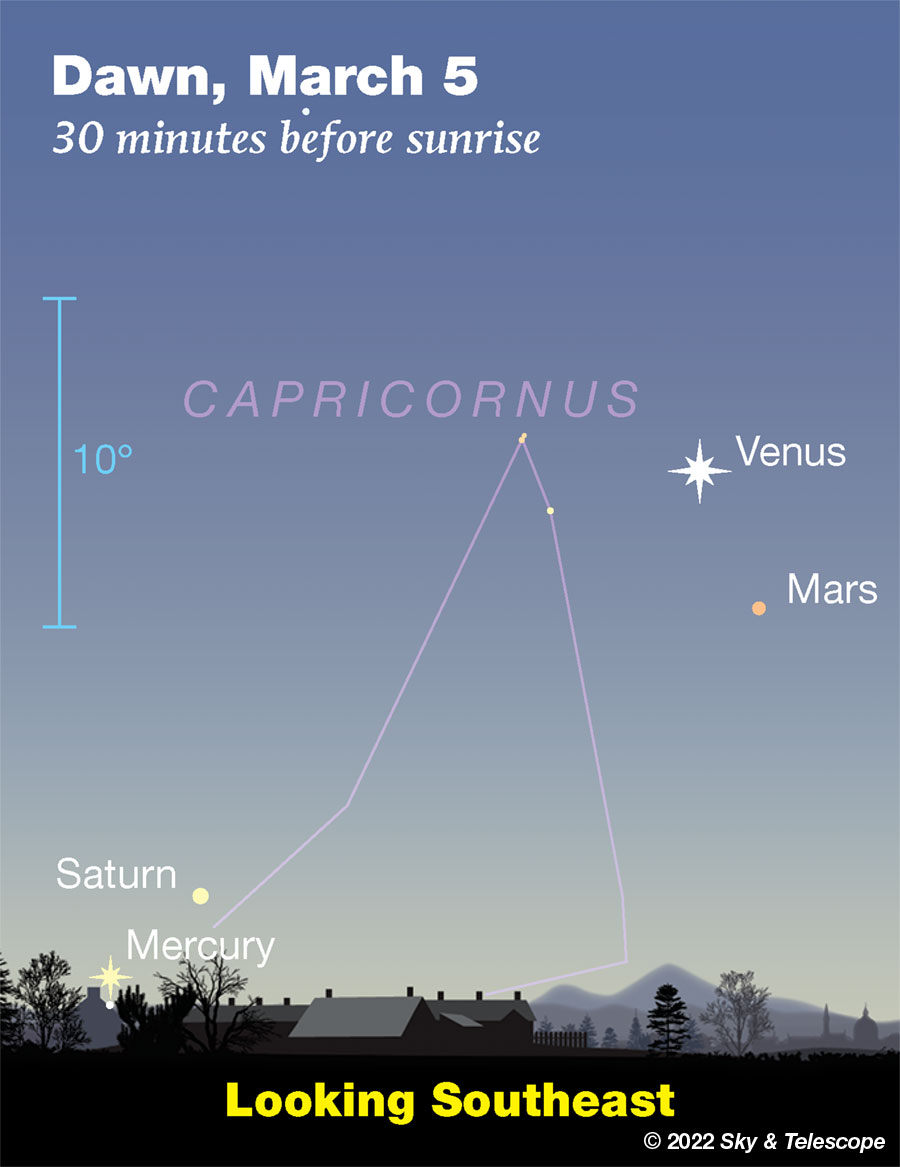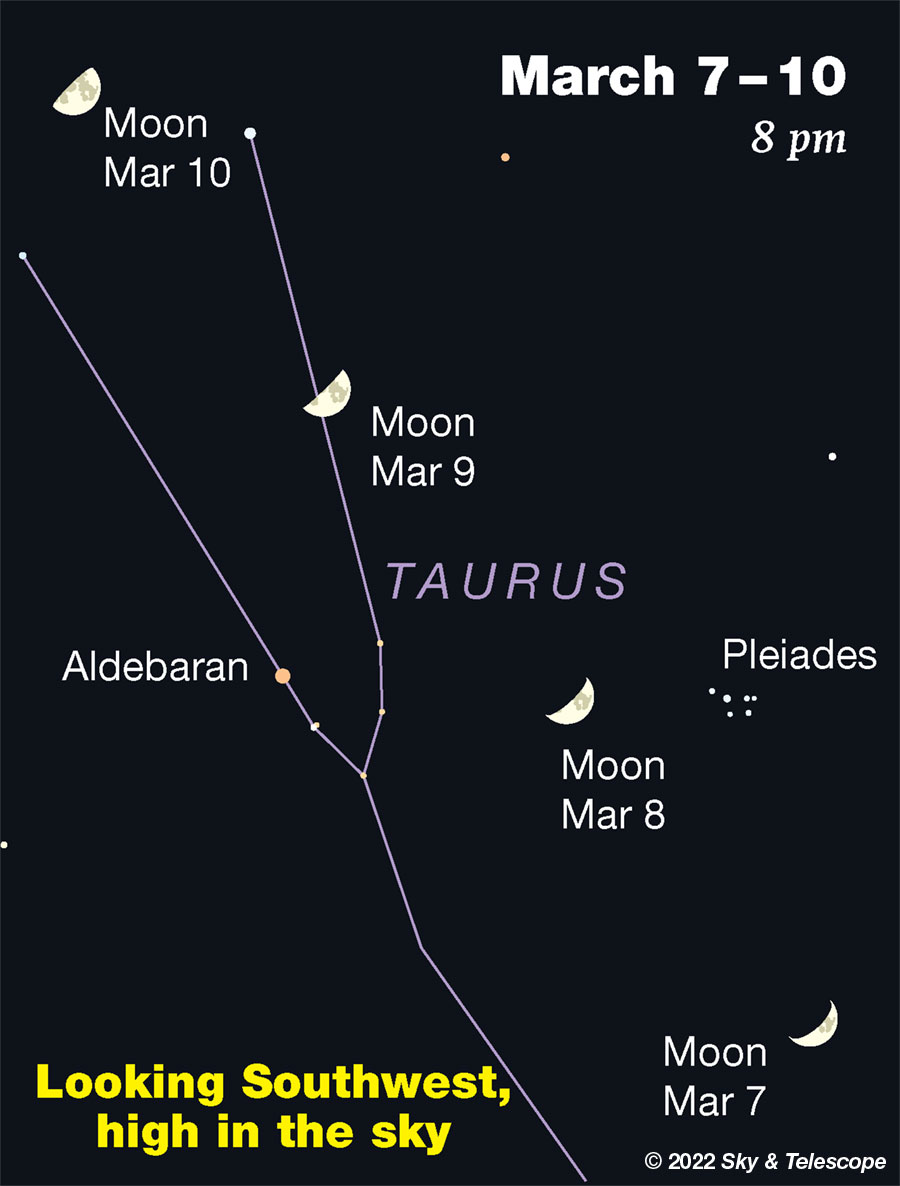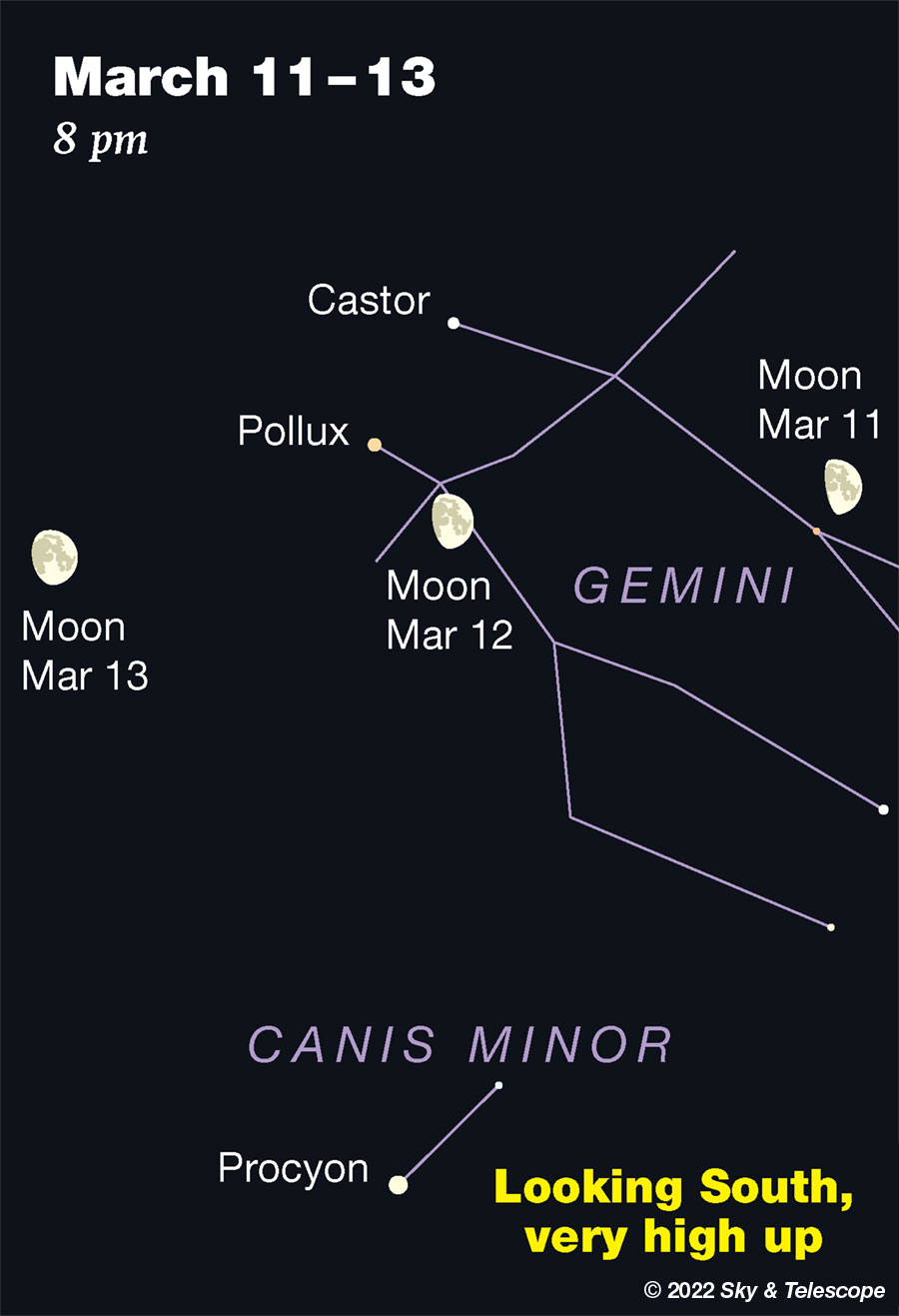FRIDAY, MARCH 4
■ February was Orion's month to stand at his highest in the south in early evening. Now March pushes him westward and brings his dog to center stage on the meridian: Canis Major, sporting Sirius on his chest.
Sirius is not only the brightest star in our sky after the Sun, it's also the closest naked-eye star after the Sun, at 8.6 light-years, for those of us living at mid-northern latitudes.
Alpha Centauri is the actual closest star at 4.3 light-years, but you have be farther south to see it. Three dim red dwarfs in the northern sky are closer than Sirius, but those require binoculars or a telescope.

SATURDAY, MARCH 5
■ Sirius now stands on the meridian just as twilight fades away into night. Sirius is the bottom star of the equilateral Winter Triangle. The other two stars of the Triangle are orange Betelgeuse to Sirius's upper right (Orion's shoulder) and Procyon to Sirius's upper left. This is the time of year when the Winter Triangle balances exactly level over Sirius shortly after nightfall.
■ Look east after dusk for Leo climbing well up the sky. Its brightest star is Regulus. The Sickle of Leo (about a fist and a half tall) extends upper left from there. The sickle includes Algieba, Gamma Leonis, second in brightness to Regulus by only a small amount.
SUNDAY, MARCH 6
■ The crescent Moon shines in the west this evening. Look about a fist at arm's length to the right of the crescent Moon this evening for the brightest two or three stars of Aries, aligned roughly vertically.
■ Sirius blazes high in the south on the meridian around the end of twilight this week. The seeing often steadies down in twilight, so this may be a good time to try for Sirius B, the Dog Star's notoriously difficult white-dwarf companion.
Sirius A and B are at their farthest apart in their 50-year orbit, separated by 11.3 arcseconds (they're exactly farthest apart next year if you're picky). They'll remain very nearly as wide for the next few years before they start closing up again.
You'll want at least an 8- or 10-inch scope and a night of really excellent seeing. Keep checking night after night; top-notch seeing makes all the difference for spotting Sirius B. See the additional tips in Bob King's article Sirius B – A New Pup in My Life.
The Pup is east-northeast of the Dog Star and 10 magnitudes fainter: one ten-thousandth as bright. As Bob recommends, put a homemade occulting bar across your eyepiece's field stop: a tiny strip of aluminum foil held to the field stop with a bit of tape, with one edge of the foil crossing the center of the field. Hide blinding Sirius A just behind the strip's eastern edge.
■ Algol shines at its minimum brightness, magnitude 3.4 instead of its usual 2.1, for a couple hours centered on 9:06 p.m. EST.
MONDAY, MARCH 7
■ It's not spring for another two weeks. But the Spring Star Arcturus rises above the east-northeast horizon fairly soon after dark now, depending on your latitude.
To see where to watch for it to come up, find the Big Dipper as soon as the stars come out. It's high in the northeast. Follow the curve of its handle down and around to the lower right by a little more than a Dipper-length. That's the spot on the horizon to watch. The farther north you are, the sooner it rises.
By 10 p.m. Arcturus is high up and dominates the eastern sky.

TUESDAY, MARCH 8
■ The nearly first-quarter Moon shines between Aldebaran to its left and the dipper-shaped Pleiades closer to its right, as shown above.
■ As spring approaches, the Big Dipper climbs as high in the northeast soon after dark as Cassiopeia has descended to in the northwest. Midway between them, as always, is Polaris.
WEDNESDAY, MARCH 9
■ First-quarter Moon this evening and tomorrow evening. The Moon is exactly first quarter at 6:45 a.m. on March 10th Eastern Standard Time; this is about halfway between the early evenings of the 9th and 10th for the Americas.
This evening, the Moon hangs inside the long, flat triangle of the Pleiades, Aldebaran, and lesser Elnath (Beta Tauri) to their upper left, as shown above.
THURSDAY, MARCH 10
■ Now the Moon shines almost equidistant from the two horntips of Taurus, Beta and fainter Zeta Tauri, as shown above. It's upper left of their midpoint during evening for North America.
FRIDAY, MARCH 11
■ The waxing gibbous Moon this evening shines high in Gemini. When you face south after dark, Pollux and fainter Castor shine about a fist at arm's length to its left, as shown below.
At roughly right angles to that direction, the Moon shines almost exactly midway between Capella and Procyon (for evening in North America), about 2½ fists from each.

SATURDAY, MARCH 12
■ Pollux and Castor accompany the Moon across the sky tonight, as shown above. Pollux is the one closest to it.
Down below this group is Procyon. Lower right of Procyon shines brighter Sirius.
■ Daylight-saving time begins at 2 a.m. tonight for most of North America. Clocks spring forward an hour.
This Week's Planet Roundup
Venus and much fainter Mars continue in early dawn this week, 4° apart in the southeast; see the scene at the top of this page. Venus blazes at magnitude –4.6. Mars is only about one two-hundredth as bright at mag +1.3. Look for Mars below or lower right of showy Venus before dawn gets too bright.
Mercury and Saturn are much lower in bright dawn, some 22° to Venus's lower left. Bring binoculars about 20 or 30 minutes before sunrise, and good luck! You'll need a very low east-southeast horizon. Saturn, magnitude +0.8, is getting a little higher and less difficult each week, but Mercury (about mag. –0.3) is fast dropping away to Saturn's lower left. Mercury is 4° lower left of Saturn on the morning of the 5th. After that, goodbye.
Jupiter is out of sight in conjunction with the Sun.
Uranus (magnitude 5.8, in Aries) is in the west right after dark.
Neptune is lost in the sunset.
All descriptions that relate to your horizon — including the words up, down, right, and left — are written for the world's mid-northern latitudes. Descriptions and graphics that also depend on longitude (mainly Moon positions) are for North America.
Eastern Standard Time, EST, is Universal Time minus 5 hours. Eastern Daylight Time, EDT, is UT minus 4 hours.
Want to become a better astronomer? Learn your way around the constellations. They're the key to locating everything fainter and deeper to hunt with binoculars or a telescope.
This is an outdoor nature hobby. For an easy-to-use constellation guide covering the whole evening sky, use the big monthly map in the center of each issue of Sky & Telescope, the essential magazine of astronomy.
Once you get a telescope, to put it to good use you'll need a detailed, large-scale sky atlas (set of charts). The basic standard is the Pocket Sky Atlas (in either the original or Jumbo Edition), which shows stars to magnitude 7.6.

Next up is the larger and deeper Sky Atlas 2000.0, plotting stars to magnitude 8.5; nearly three times as many. The next up, once you know your way around, are the even larger Interstellarum atlas (stars to magnitude 9.5) or Uranometria 2000.0 (stars to magnitude 9.75). And be sure to read How to Use a Star Chart with a Telescope. (It applies just as much to charts on your phone or tablet as to charts on paper.)
You'll also want a good deep-sky guidebook. A beloved old classic is the three-volume Burnham's Celestial Handbook. An impressive more modern one is the big Night Sky Observer's Guide set (2+ volumes) by Kepple and Sanner.
Can a computerized telescope replace charts? Not for beginners, I don't think, and not on mounts and tripods that are less than top-quality mechanically, meaning heavy and expensive. And as Terence Dickinson and Alan Dyer say in their Backyard Astronomer's Guide, "A full appreciation of the universe cannot come without developing the skills to find things in the sky and understanding how the sky works. This knowledge comes only by spending time under the stars with star maps in hand."
![]() Audio sky tour. Out under the evening sky with your
Audio sky tour. Out under the evening sky with your
earbuds in place, listen to Kelly Beatty's monthly
podcast tour of the heavens above. It's free.
"The dangers of not thinking clearly are much greater now than ever before. It's not that there's something new in our way of thinking, it's that credulous and confused thinking can be much more lethal in ways it was never before."
— Carl Sagan, 1996
"Facts are stubborn things."
— John Adams, 1770
 2
2









Comments
Rod
March 4, 2022 at 10:07 am
I was able to enjoy an early morning meeting today with Venus and Mars. [Observed 0515-0600 EST/1015-1100 UT. Sunrise 0634 EST/1134 UT. Venus 30.08 arcsecond angular size and 40.3% illuminated. Mars 4.74 arcsecond angular size and 93.8% illuminated according to Stellarium 0.21.3. Venus ~ 0.555 au and Mars ~ 1.974 au. 61 Sagittarii (61 Sgr) star visible in FOV with Venus at 25x this morning and 10x50 binocular views. 61 Sgr distance according to Stellarium 0.21.3, 259 LY. Stellarium 0.21.3 angle mode shows 61 Sgr and Venus separated by close to 76 arcminutes. My true FOV at 25x ~ 108 arcminute so 61 Sgr and Venus visible in the FOV. I used 10x50 binoculars to view Venus and Mars also. Venus near half-moon shape obvious in the 90-mm refractor telescope at 25x using TeleVue 40-mm plossl eyepiece. An enjoyable early morning meeting with Venus and Mars in Sagittarius. Temperature -3C with winds 020/7 knots.]
You must be logged in to post a comment.
misha17
March 5, 2022 at 12:11 am
Last weekend was a better match, but this weekend is still a good time to get ready for the Oct 14, 2023, solar eclipse.
On Saturday, declination will be 5 degrees, 47 minutes South, versus 8 degrees 16 minutes on Oct 14, 2023.
Solar Noon is 12:05pm on March 5, versus 12:39pm Standard Time (1:39pm Daylight Time).
Go here to get your local times for the eclipse, then go out 34 minutes earlier to see where the sun will be.
https://eclipse2024.org/2023eclipse/eclipse_cities/
You can use this to find good locations to "frame" the eclipse.
You must be logged in to post a comment.
You must be logged in to post a comment.